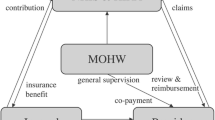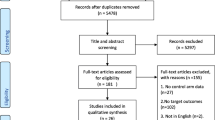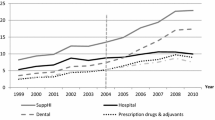Abstract
This study estimates the effect of complementary private health insurance (PHI) on the use of health care. The empirical analysis focuses on an institutional setting in which empirical findings are still limited; namely on PHI covering co-payment for treatments that are only partly financed by a universal health care system. The analysis is based on Danish data recently collected specifically for this purpose, which makes identification strategies assuming selection on observables only, and on both observables and unobservables also, both plausible and possible. We find evidence of a substantial positive and significant effect of complementary PHI on the use of prescription medicine and chiropractic care, a smaller but significant effect on dental care, weaker indications of effects for physiotherapy and general practice, and finally that the use of hospital-based outpatient care is largely unaffected. This implies that complementary PHI is generally not simply a marker of a higher propensity to use health care but induces additional use of some health care services over and above what would be used in the absence of such coverage.
Similar content being viewed by others
Notes
If, for example, the universal health care system covers 60 % of a physiotherapy treatment worth EUR 50 and the remaining 40 % is financed by a co-payment—which may or may not be covered by complementary insurance—and complementary insurance induces three additional visits at EUR 50 over and above what would have been used in its absence, the presence of complementary insurance leaves the universal health care system with an additional expenditure of EUR 0.6 * 150 \(=\) 90.
This approach has also been examined in the current study, but most bounds were too wide to be of any value.
Conversions from DKK to EUR were undertaken using the March 2011 average exchange rate of 745.74. (Danske Bank 2011).
The Danish Health Interview Survey (in Danish: Sundhed og Sygelighed i Danmark) contains information on private health insurance coverage and health care use in the Danish population. However, the level of detail of the information on private health insurance coverage is considerably lower than that of the data used here.
Based on the observed pattern, one might speculate that it is easier to remember visits for which a co-payment was made, sometimes perhaps even more visits than actually took place.
Probability weights are defined as the inverse of the probability that the individual under consideration was sampled from the population, i.e. the number of individuals in the population that each sampled respondent represents.
We perform a sensitivity analysis to check whether excluding passive individuals or classifying them as being insured changes the results substantially.
The choice of dummy variables indicating whether any use took place is motivated by the fact that the main choice that individuals face is whether to see a given health care provider or not, while further visits are, to a large extent, beyond their control (Barros et al. 2008; Gerfin and Schellhorn 2006). Moreover, a dummy variable captures the majority of the variation in outcomes, due to there being a large number of zeros and ones in the number of contacts.
All complementary insurance plans cover a maximum of DKK 360/USD 68 for single focal glasses or sunglasses, DKK 680/USD 128 for multifocal glasses and DKK 38/USD 7 per month for contact lenses (Health Insurance ’danmark’ 2010a). This is almost half the premium for complementary insurance coverage.
We have also estimated the models using univariate probit models, and the results are very similar to the matching results, indicating that functional form assumptions are not a problem. However, these are not reported, due to considerations of space.
A related estimator is the two-stage least squares estimator, but due to the discrete nature of both treatment and outcomes this will at best be an approximation.
The propensity score matching estimator was implemented using version 3.1.5 of the ‘psmatch2’ module written by Leuven and Sianesi (2003).
Sensitivity analyses, which are available from the corresponding author upon request, showed that the results are insensitive to reducing the bandwidth to 0.02 and increasing it to 0.06 and 0.08, respectively.
The average treatment effects for the treated are very similar and are hence not presented.
References
Abadie, A., & Imbens, G. W. (2008). On the failure of the bootstrap for matching estimators. Econometrica, 76, 1537–1557.
Anderson, M., Dobkin, C., & Gross, T. (2012). The effect of health insurance coverage on the use of medical services. American Economic Journal, 4, 1–27.
Angrist, J. D., Imbens, G. W., & Rubin, D. B. (1996). Identification of the causal effects using instrumental variables. Journal of the American Statistical Association, 91, 444–455.
Arrow, K. J. (1963). Uncertainty and the welfare economics of medical care. American Economic Review, 53, 941–973.
Barros, P. P., Machado, M. P., & Sanz-de-Galdeano, A. (2008). Moral hazard and the demand for health services: A matching estimator approach. Journal of Health Economics, 27, 1006–1025.
Bolhaar, J., Lindeboom, M., & Klaauw, B. (2012). A dynamic analysis of the demand for health insurance and health care. European Economic Review, 56, 669–690.
Buchmueller, T. C., Couffinhal, A., Grignon, M., & Perronnin, M. (2004). Access to physician services: Does supplemental insurance matter? Evidence from France. Health Economics, 13, 669–687.
Cameron, A. C., & Trivedi, P. K. (2005). Microeconometrics: Methods and applications. New York: Cambridge University Press.
Cameron, A. C., Trivedi, P. K., Milne, F., & Piggott, J. (1988). A microeconometric model of the demand for health care and health insurance in Australia. Review of Economic Studies, 1, 85–106.
Card, D., Dobkin, C., & Maestas, N. (2008). The impact of nearly universal coverage on health care utilization: Evidence from Medicare. American Economic Review, 98, 2242–2258.
Chiappori, P., Durand, F., & Geoffard, P. (1998). Moral hazard and the demand for physician services: First lessons from a French natural experiment. European Economic Review, 42, 499–511.
Christiansen, T., Lauridsen, J., & Kamper-Jørgensen, F. (2002). Demand for private health insurance and demand for health care by privately and non-privately insured in Denmark (Working paper), University of Southern Denmark, Odense.
Colombo, F., & Tapay, N. (2004). Private health insurance in OECD countries: The benefits and costs for individuals and health systems. In Towards high-performing health systems: policy studies. Paris: OECD.
Coulson, N. E., Terza, J. V., Neslusan, C. A., & Bruce, S. (1995). Estimating the moral-hazard effect of supplemental medical insurance in the demand for prescription drugs by the elderly. American Economic Review, 85, 122–126.
Cutler, D. M., & Zeckhauser, R. J. (2000). The anatomy of health insurance. In A. J. Culyer & J. P. Newhouse (Eds.), Handbook of health economics. Amsterdam: Elsevier.
Danske Bank (2011, April 27). Middelkurser i København, marts 2011 [Average exchange rates in Copenhagen, March 2011].
de Meza, D. (1983). Health insurance and the demand for medical care. Journal of Health Economics, 2, 47–54.
de Meza, D., & Webb, D. C. (2001). Advantageous selection in insurance markets. RAND Journal of Economics, 32, 249–262.
Doorslaer, Ev, Koolman, X., & Jones, A. M. (2004). Explaining income-related inequalities in doctor utilization in Europe. Health Economics, 13, 629–647.
Evans, R. G. (1974). Supplier-induced demand: Some empirical evidence and implications. In M. Perlman (Ed.), The economics of health and medical care. New York: Wiley.
Finkelstein, A., & McGarry, K. (2006). Multiple dimensions of private information: Evidence from the long-term care insurance market. American Economic Review, 96, 938–958.
Fletcher, J. M., & Frisvold, D. E. (2009). Higher education and health investments: Does more schooling affect preventive health care use? Journal of Human Capital, 3, 144–176.
Folland, S., Goodman, A. C., & Stano, M. (2007). The economics of health and health care. New Jersey: Pearson.
Gerfin, M., & Schellhorn, M. (2006). Nonparametric bounds on the effect of deductibles in health care insurance on doctor visits—Swiss evidence. Health Economics, 15, 1011–1020.
Harmon, C., & Nolan, B. (2001). Health insurance and health services utilization in Ireland. Health Economics, 10, 135–145.
Health Insurance ‘danmark’ (2009). Årsrapport 2009 [Annual Report 2009]. Retrieved April, 2011, from http://www.sygeforsikring.dk/Default.aspx?ID=23.
Health Insurance ‘danmark’ (2010a). Dækning [Coverage]. Retrieved May, 2011, from http://www.sygeforsikring.dk/Default.aspx?ID=439
Health Insurance ‘danmark’ (2010b). Helbreds- og alderskrav [Health- and age requirements]. Retrieved May 25, 2011, from http://www.sygeforsikring.dk/Default.aspx?ID=343.
Hemenway, D. (1990). Propitious selection. Quarterly Journal of Economics, 105, 1063–1069.
Höfter, R. H. (2006). Private health insurance and utilization of health services in Chile. Applied Economics, 38, 423–439.
Holly, A., Lucien, G., Gianfranco, D., & Brigitte, B. (1998). An econometric model of health care utilization and health insurance in Switzerland. European Economic Review, 42, 513–522.
Hopkins, S., Kidd, M. P., & Ulker, A. (2013). Private health insurance status and utilisation of dental services in Australia. Economic Record, 89(285), 194–206.
Jacobsen, C. S. (2009). Hvad optikeren skal, må og absolut ikke må [What the optician must, may and definitely may not]. Retrieved February 16, 2016, from http://www.optikerforeningen.dk/Files/Billeder/2010_og_tidligere/Artikler/2009_3_1_Hvad_optikeren_maa.pdf.
Jones, A. M., Koolman, X., & van Doorslaer, E. (2006). The impact of having supplementary private health insurance in the use of specialists. Annales d’Economie et de Statistiques, 83–84, 251–275.
Kaestner, R., & Khan, N. (2012). Medicare part D and its effect on the use of prescription drugs, use of other health care services and health of the elderly. Journal of Policy Analysis and Management, 31, 253–279.
Kiil, A. (2011a). Determinants of employment-based private health insurance in Denmark. Nordic Journal of Health Economics, 1, 1–47.
Kiil, A. (2011b). Private health insurance in a universal tax-financed health care system—An empirical investigation. PhD thesis, University of Southern Denmark. Retrieved September 11, 2015, from http://www.kora.dk/media/339382/aki_private_health_insurance.pdf.
Kiil, A. (2012). Does employment-based private health insurance increase the use of covered health care services? A matching estimator approach. International Journal of Health Care Finance and Economics, 12, 1–38.
Kiil, A., & Pedersen, K. M. (2009). The Danish survey of voluntary health insurance 2009. Data documentation: Population, design, and descriptive statistics (Working paper), University of Southern Denmark.
Larsen, B. (2013). Briller og kontaktlinser [Glasses and contact lenses]. Retrieved February 16, 2016, from http://www.netdoktor.dk/ojne/briller_linser.htm.
Leuven, E., & Sianesi, B. (2003). PSMATCH2: Stata module to perform full Mahalanobis and propensity score matching, common support graphing, and covariate imbalance testing. Version 3.1.5. Retrieved April 29, 2011, from http://ideas.repec.org/c/boc/bocode/s432001.html.
Manning, W. G., Newhouse, J. P., Duan, N., Keeler, E., Benjamin, B., Leibowitz, A., et al. (1987). Health insurance and the demand for medical care: Evidence from a randomized experiment. American Economic Review, 77, 251–277.
Manski, C. F., & Pepper, J. (2000). Monotone instrumental variables: With an application to the returns to schooling. Econometrica, 68, 997–1010.
Nocetti, D., & Smith, W. T. (2010). BE Journal of Economic Analysis & Policy, 10(1).
Nyman, J. A., & Maude-Griffin, R. (2001). The welfare economics of moral hazard. International Journal of Health Care Finance and Economics, 1, 23–42.
OECD (2004). Proposal for a taxonomy of health insurance. OECD study of private health insurance (Working document). Paris: OECD.
OECD (2010). Health data: Health expenditure by financing agent/scheme (Data tables). Retrieved May 3, 2011, from www.oecd.org/dataoecd/46/36/38979632.xls.
Pauly, M. V. (1968). The economics of moral hazard: Comment. American Economic Review, 58, 531–537.
Pedersen, K. M. (2005). Voluntary supplementary health insurance in Denmark. Public Finance and Management, 5, 544–566.
Riphahn, R. T., Wambach, A., & Million, A. (2003). Incentive effects in the demand for health care: A bivariate panel count data estimation. Journal of Applied Econometrics, 18, 387–405.
Ruthledge, M. S. (2009). Asymmetric information and the generosity of employer-sponsored health insurance. PhD thesis, University of Michigan, Ann Arbor.
Savage, E., & Wright, D. J. (2003). Moral hazard and adverse selection in Australian private hospitals. Journal of Health Economics, 22, 331–359.
Schellhorn, M. (2001). The effect of variable health insurance deductibles on the demand for physician visits. Health Economics, 10, 441–456.
Schokkaert, E., van Ourti, T., de Graeve, D., Lecluyse, A., & van de Voorde, C. (2010). Supplemental health insurance and equality of access in Belgium. Health Economics, 19, 377–395.
Søgaard, R., Bech, M., & Olsen, J. (2011). Effekten af private sundhedsforsikringer på forbruget af offentligt finansierede sundhedsydelser [The effect of private health insurances on the use of publicly financed hospital services (Report)], Centre for Applied Health Services Research and Technology Assessment (CAST), Odense.
Stabile, M. (2001). Private insurance subsidies and public health care markets: Evidence from Canada. The Canadian Journal of Economics, 34, 921–942.
Statistics Denmark (2009a). Befolkningens brug af internet 2009 [Population internet use 2009]. Retrieved April 29, 2011, from http://www.dst.dk/pukora/epub/upload/14039/it.pdf.
Statistics Denmark (2009b). Various tables from StatBank Denmark. Retrieved August 7, 2009, from www.statistikbanken.dk/statbank5a/default.asp?w=1280.
Statistics Denmark (2010). AKU1: Population (15–66 years) in thousands by labour status, age and sex. BEF05 (18–75). (Data tables). Retrieved April 29, 2011, from http://www.statistikbanken.dk/statbank5a/default.asp?w=1280.
Strandberg-Larsen, M., Nielsen, M. B., Vallgårda, S., Krasnik, A., & Mossialos, E. (2007). Denmark: Health system review. Health Systems in Transition, 9(6), 1–164.
The Danish Insurance Association (2010). Sundhedsforsikringer - hovedtal 2003–2008 [Health insurance—Key figures 2003–2008]. (Data tables). Retrieved April 29, 2011, from http://www.forsikringogpension.dk/presse/Statistik_og_Analyse/statistik/forsikring/antal/Documents/Sundhedsforsikring%20--%20Antal%20forsikrede,%20pr%E6mier%20og%20erstatninger/Sundhedsforsikringer_2009.pdf.
Vera-Hernández, A. M. (1999). Duplicate coverage and the demand for health care: The case of Catalonia. Health Economics, 8, 579–598.
Wilde, J. (2000). Identification of multiple equation probit models with endogenous dummy regressors. Economic Letters, 69, 309–312.
Acknowledgments
The collection of the data used in the article was supported financially by the Danish Health Insurance Foundation (Helsefonden). The paper has benefitted greatly from discussions with Kjeld Møller Pedersen, Tor Iversen, Terkel Christiansen, Kristian Bolin, Lars Peter Østerdal, and participants in the 2010 Nordic Health Economists’ Study Group Meeting in Umeå, the 2011 Danish Symposium in Applied Statistics in Copenhagen and the 8th World Congress on Health Economics (IHEA), 2011, in Toronto. We also gratefully acknowledge the comments of two anonymous reviewers. Any errors are the responsibility of the authors.
Author information
Authors and Affiliations
Corresponding author
Appendices
Appendix 1: Regression results
This appendix contains the regression results underlying the parametric models for which treatment effects are presented in Table 5.
See Table 6.
Appendix 2: Assessment of matching quality and common support
This appendix contains some diagnostics of matching quality for the propensity score matching estimator.
Rights and permissions
About this article
Cite this article
Kiil, A., Arendt, J.N. The effect of complementary private health insurance on the use of health care services. Int J Health Econ Manag. 17, 1–27 (2017). https://doi.org/10.1007/s10754-016-9195-3
Received:
Accepted:
Published:
Issue Date:
DOI: https://doi.org/10.1007/s10754-016-9195-3
Keywords
- Private health insurance
- Moral hazard
- Health care utilization
- Treatment effects
- Parametric estimators
- Propensity score matching





